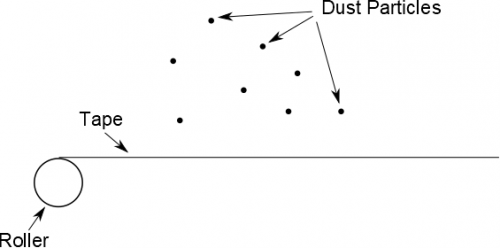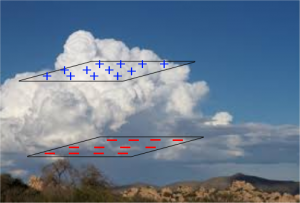Project 4
Project 4A: StickyStuff and the Dust Particle
 Adhesive tape is manufactured by repeatedly rolling and unrolling large sheets of plastic, which can cause there to be a charge on the surface of the tape.
Adhesive tape is manufactured by repeatedly rolling and unrolling large sheets of plastic, which can cause there to be a charge on the surface of the tape.
You are a group of adhesive engineers at StickyStuff Corporation and unfortunately, there has recently been a dust problem in the manufacturing plant. Dust particles (on average, $charge=0.802*10^{-14} C$, $m=5.5*10^{-8} g$) have been accumulating on the tape as it rolls through the assembly line. You've isolated the problem to a single roller ($\omega=12 \frac{rad}{s}$, $r=25 cm$) on the line. This roller operates at $P=100 W$ for $t=10 s$ at a time. Your team needs to determine where to put a fan and how much force the fan needs to exert on each dust particle, such that the fan blows away any dust that may be attracted to the tape. From your adhesive engineering education, you have access to a table that you think may help.
(There's actually a pretty cool “How it's Made” video here if you have time at the end.)
Project 4B: Better Thundercloud Model
 Your colleagues back in Lakeview have called again as the storms continue to get worse. While they greatly appreciated the model you created last week for the Mapping N$\vec{E}$twork Sensory Array (MNSA), the data they are collecting from the sensors are simply not matching the model's predictions. They have concluded that modeling storm clouds as point charges was, in fact, problematic. Based on some research from the National Weather Service, it looks like a better model for clouds would be two flat sheets of charge since the negative charges in the cloud collect on the bottom of the cloud and the positive charges collect near the top.
Your colleagues back in Lakeview have called again as the storms continue to get worse. While they greatly appreciated the model you created last week for the Mapping N$\vec{E}$twork Sensory Array (MNSA), the data they are collecting from the sensors are simply not matching the model's predictions. They have concluded that modeling storm clouds as point charges was, in fact, problematic. Based on some research from the National Weather Service, it looks like a better model for clouds would be two flat sheets of charge since the negative charges in the cloud collect on the bottom of the cloud and the positive charges collect near the top.
Given that the negative charge is much closer to the ground (and headquarters), the Lakeviewians want to prioritize what the Mapping N$\vec{E}$twork Sensory Array (MNSA) around HQ will show based on the bottom of the cloud. (If you have time though, they'd be interested in whether the top of the cloud has any effect.) They have shared their model of the bottom of the most recent storm cloud (which is thankfully fully functioning, well-commented code), but they are having trouble getting the electric field on the ground. The Lakeviewians have asked your team for your help completing the code.
#Set up of the objects
ground = box(pos = vec(0,0,0), width=5000, length=5000, height=0.1, color=color.green)
mountains = [cone(pos=vec(-1800,0,0), axis=vec(0,1000,0), radius=700, color=vec(1,0.7,0.2)),
cone(pos=vec(-1800,0,-1600), axis=vec(0,1000,0), radius=700, color=vec(1,0.7,0.2)),
cone(pos=vec(-1800,0,1600), axis=vec(0,1000,0), radius=700, color=vec(1,0.7,0.2))]
HQ = box(pos = vec(-100,100,0), width = 15, length = 15, height= 200, color = color.blue)
cloud = box(pos = vector(0,1000,0), size = vector(500, 1, 500), color = color.white)
#Lines 13-48 create a grid of spheres to represent the bottom of the cloud:
#Define how many chunks to split the cloud in the x direction (define x size of the cloud grid)
nx = 10
#Define how many chunks to split the cloud in the z direction (define z size of the cloud grid)
nz = 10
#Define where the cloud should start/stop in the x direction
startx = -250
endx = 250
#Define the spacing between each chunk in the x, based on where the cloud start/stops and how many chunks there are
stepx = (endx - startx)/nx
#Define where the cloud should start/stop in the z direction
startz = -250
endz = 250
#Define the spacing between each chunk in the z, based on where the cloud start/stops and how many chunks there are
stepz = (endz - startz)/nz
#Create an empty list to store each cloud chunk
listOfCloudChunks = []
#For each cloud chunk in the x-direction
for i in range(0,nx):
#Define the x-location of the cloud chunk
xloc = startx + i*stepx
#For each cloud chunk in the z-direction
for j in range(0,nz):
#Define the z-location of the cloud chunk
zloc = startz + j*stepz
#Make a sphere at that x-z location
cloudChunk = sphere(pos = vector(xloc,1000,zloc), radius = 50, color = color.red)
#Add the sphere to the list of cloud chunks (so we can use it later)
listOfCloudChunks.append(cloudChunk)
#This part needs to be fixed and commented...
obsLocation = vector(0,0,0)
Enet = vector(0,0,0)
Q = -15
dQ = Q/(nx*nz)
k = 9e9
for chunk in listOfCloudChunks:
Enet = vector(0,0,0)